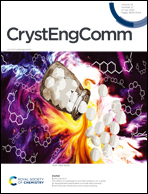Switchable dielectric constant, structural and vibrational studies of double perovskite organic–inorganic hybrids: (azetidinium)2[KCr(CN)6] and (azetidinium)2[KFe(CN)6]†
Abstract
We have synthesized and characterized two novel organic–inorganic hybrid crystals: (C3H8N)2[KCr(CN)6] (AZECr) and (C3H8N)2[KFe(CN)6] (AZEFe). Thermal DSC, TG and DT analyses indicate that each compound undergoes one structural phase transition (PT). AZECr and AZEFe undergo a structural phase transition each upon cooling at 171 and 186 K, respectively. The crystal structures are refined for AZECr-high-temperature, AZECr-low-temperature, and AZEFe-high-temperature at 210 K, 120, and 240 K, respectively. AZECr and AZEFe are isomorphous at the high-temperature (HT) phase and are characterized by a three-dimensional framework consisting of [X4K4(CN)12] (where X are CrIII or FeIII) cages formed by X–C![[triple bond, length as m-dash]](https://www.rsc.org/images/entities/char_e002.gif) N–K fragments, which are filled by guest azetidinium (AZE+) cations. The crystal system changes during the PT in AZECr from the HT phase to the low-temperature (LT) phase, as shown at 120 K, where the crystal adopts the P21/c monoclinic space group. The AZE+ cations and the CN− bridges, which were highly disordered in the HT phase, are fully ordered in the LT one. AZEFe-LT diffraction data reveal extensive twinning of the crystal, and, unfortunately, our attempts to solve the structure of the crystal were unsuccessful. To compare and obtain insight into the mechanisms of PTs in these crystals, we measured the infrared (IR) spectra in a wide wavenumber range from middle IR (MIR) to far IR (FIR). IR measurements fully confirm that both samples are isomorphous at the HT phase. However, in the LT phase, the spectra are different, which means that the LT phases are not identical and may suggest that AZECr-LT and AZEFe-LT are not isomorphous. Additionally, to confirm the change in dynamical states of molecules in PT, dielectric measurements were carried out between 150 and 300 K in the frequency range of 25 Hz to 2 MHZ. It was shown that the permittivity value can be switched between two states: ON (a high ε′ value, HT) and OFF (a low ε′ value, LT).
N–K fragments, which are filled by guest azetidinium (AZE+) cations. The crystal system changes during the PT in AZECr from the HT phase to the low-temperature (LT) phase, as shown at 120 K, where the crystal adopts the P21/c monoclinic space group. The AZE+ cations and the CN− bridges, which were highly disordered in the HT phase, are fully ordered in the LT one. AZEFe-LT diffraction data reveal extensive twinning of the crystal, and, unfortunately, our attempts to solve the structure of the crystal were unsuccessful. To compare and obtain insight into the mechanisms of PTs in these crystals, we measured the infrared (IR) spectra in a wide wavenumber range from middle IR (MIR) to far IR (FIR). IR measurements fully confirm that both samples are isomorphous at the HT phase. However, in the LT phase, the spectra are different, which means that the LT phases are not identical and may suggest that AZECr-LT and AZEFe-LT are not isomorphous. Additionally, to confirm the change in dynamical states of molecules in PT, dielectric measurements were carried out between 150 and 300 K in the frequency range of 25 Hz to 2 MHZ. It was shown that the permittivity value can be switched between two states: ON (a high ε′ value, HT) and OFF (a low ε′ value, LT).
![Graphical abstract: Switchable dielectric constant, structural and vibrational studies of double perovskite organic–inorganic hybrids: (azetidinium)2[KCr(CN)6] and (azetidinium)2[KFe(CN)6]](/en/Image/Get?imageInfo.ImageType=GA&imageInfo.ImageIdentifier.ManuscriptID=D2CE00270A&imageInfo.ImageIdentifier.Year=2022)


 Please wait while we load your content...
Please wait while we load your content...